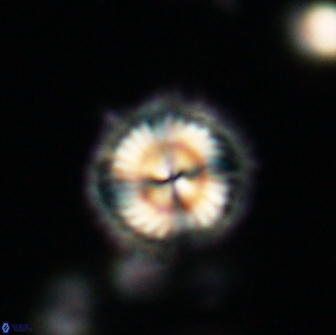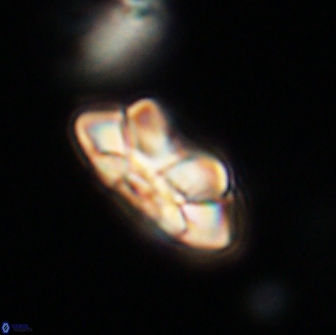Noelia kolona
Noelia kolona Varol, 2023
A circular species of Noelia consisting of a nonbirefringent distal shield, an appressed proximal shield and a broad distally protruding tube cycle with a serrated periphery.
From the Greek kolona, column – refers to its high, protruding tube cycle.
The diameter of the distal shield: 8.98μm (measured in plan view in phase-contrast), the diameter of the proximal shield: 4.80 μm (measured in side view in cross-polarised light), the maximum diameter of the tube cycle: 4.92 μm (measured in plan view in phase-contrast), the maximum thickness of the distal shield and tube cycle: 4.17 μm (measured in cross-polarised light), the free length of the tube cycle: 1.31 μm (measured in side view in cross-polarised light).
A large (8.0–11.0 μm) species of Noelia with a nonbirefringent lenticular distal shield. The distal shield and the tube cycle are constructed of a similar number of segments (about 24–36). The number of segments in the tube cycle is easily determined in a bright field setting and cross-polarised light with a gypsum plate (Plate 12, Figs. 20, 22 in Varol, 2023). The tube cycle and the appressed proximal shield appear as an asymmetrical X-shape in side view (Plate 11, Figs. 2,6 in Varol, 2023). The diameter of the broad tube cycle is much greater than the width of the shield and constantly protrudes distally above the distal shield. There is a distinct depression at the distal end of the tube cycle.
In cross-polarised light, when using the gypsum plate, the blue regions correspond to the horizontal axis on the distal side (Plate 12, Fig. 22 in Varol, 2023). In contrast, the blue sectors correspond to the vertical axis on the proximal side in the centre of the coccolith (Plate 12, Fig. 24 in Varol, 2023).
Noelia kolona differs from Noelia mahaniae by being circular rather than subcircular with an elliptical central area. Noelia kolona is differentiated from Noelia uenverdii by the lack of a central opening, whilst the latter has a narrow central opening. Noelia kolona is recognised from Senelia, Carlamuelleria, Markalius and Davidbukrya by having a protruding tube cycle above the distal shield. The tube cycle in Senelia, Markalius and Davidbukrya does not protrude above the distal shield. Moreover, Noelia kolona is further distinguished from Davidbukrya, Carlamuelleria and Markalius by having an appressed proximal shield. In contrast, the proximal shield in Markalius is a spaced proximal shield with an acute inclination angle. Carlamuelleria and Davidbukrya have a vestigial, diminutive, or no proximal shield, respectively.
Varol, O. 2023. New paleocene calcareous nannofossils: Carlamuelleria, Davidbukrya, Mauriceblackia, Noelia and Senelia. Marine Micropaleontology. 180: 1-41.



